Two powerful earthquakes struck Asia early yesterday, killing one and injuring scores in coastal Japan and sending panicked residents into the streets as tsunami warnings were issued for countries skirting the Indian Ocean that were devastated by a deadly 2004 quake and tsunami.
The US Geological Survey said the first quake, registering magnitude 7.6, hit the Indian Ocean about 257km north of Port Blair in India’s Andaman Islands. A tsunami watch was called for India, Myanmar, Indonesia, Thailand and Bangladesh, but was later lifted.
T. Ramakrishnan, a police official in Port Blair, said there were no injuries or damage caused by the quake.
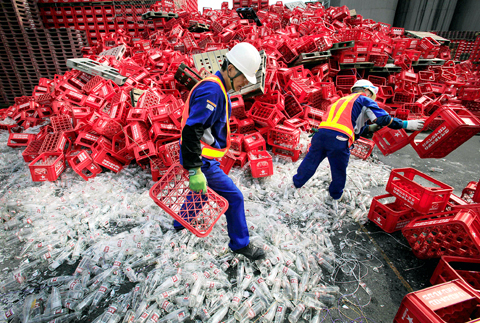
PHOTO: AP
“But people ran out of their homes in fear as they remembered the 2004 tsunami,” he said, referring to waves triggered by a magnitude-9 earthquake that killed 230,000 people in a dozen countries around the Indian Ocean.
The quake was centered at a depth of 33km, the US Geological Survey said. An aftershock measuring 4.8 shook the same area 15 minutes later at a depth of 35km, it said.
In Japan, one person was killed and at least 101 others injured, mostly by falling objects such as TV sets, when a 6.5-magnitude quake hit Tokyo and nearby areas shortly after dawn, halting trains and forcing two nuclear reactors to shut down for safety checks.
Police said one 43-year-old woman was killed by falling debris. Japan’s public broadcaster, NHK, reported that more than 80 people suffered minor injuries.
Japan’s Meteorological Agency — which downgraded the quake from magnitude 6.6 — also issued a tsunami warning, but that was later lifted. The quake hit in Suruga Bay on the Pacific Ocean coast, about 170km southwest of Tokyo, at a depth of 27km, the US Geological Survey said.
The two quakes — though likely not related — hit about 10 minutes apart.
“The shaking was quite strong, even here. It wasn’t the usual little ones,” said Mitsuharu Wakamori, a police official in Aichi, about 140km west of the epicenter.
“It was a huge tremble, like nothing I had experienced before,” said Tadao Negami, a 69-year-old resident of Mishima city in Shizuoka.
Two reactors at the Hamaoka nuclear power plant were temporarily halted for safety checks. Reactors are automatically shut down whenever a quake of a certain strength is registered.
Koki Saguchi of Chubu Electric Power Co said no problems or damage were initially detected at the reactors. Plant workers were to inspect the reactors fully before resuming operation, which was expected to take at least half a day.
The temblor prompted Central Japan Railway Co to briefly stop operations of Shinkansen bullet trains, and some local trains were still out of service hours later, the company said.
A large landslide triggered by the quake damaged the Tomei Expressway at Makinohara, Shizuoka, causing long traffic jams.
In Shizuoka city, parts of the stone wall around the 424-year-old Sunpu castle collapsed, castle park official Yasushi Watanabe said.
Japanese Prime Minister Taro Aso’s office set up an emergency center shortly after the quake, which was followed by 13 noticeable aftershocks.
Japan’s Meteorological Agency was also monitoring Tropical Storm Etau, which had threatened to bring strong rains to Tokyo but then veered east, away from the Japanese coast.
Torrential rains triggered by Etau have soaked much of the country since the weekend, and floods and landslides caused by the downpours had killed 14 people by Monday and left 18 missing.
The weather agency warned of more landslides as water-soaked earth may have become unstable after being jolted by the tremor.
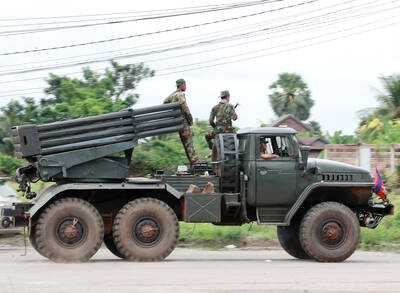
POLITICAL PATRIARCHS: Recent clashes between Thailand and Cambodia are driven by an escalating feud between rival political families, analysts say The dispute over Thailand and Cambodia’s contested border, which dates back more than a century to disagreements over colonial-era maps, has broken into conflict before. However, the most recent clashes, which erupted on Thursday, have been fueled by another factor: a bitter feud between two powerful political patriarchs. Cambodian Senate President and former prime minister Hun Sen, 72, and former Thai prime minister Thaksin Shinawatra, 76, were once such close friends that they reportedly called one another brothers. Hun Sen has, over the years, supported Thaksin’s family during their long-running power struggle with Thailand’s military. Thaksin and his sister Yingluck stayed
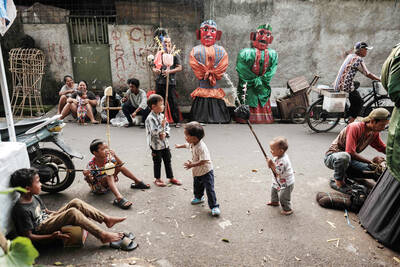
In the sweltering streets of Jakarta, buskers carry towering, hollow puppets and pass around a bucket for donations. Now, they fear becoming outlaws. City authorities said they would crack down on use of the sacred ondel-ondel puppets, which can stand as tall as a truck, and they are drafting legislation to remove what they view as a street nuisance. Performances featuring the puppets — originally used by Jakarta’s Betawi people to ward off evil spirits — would be allowed only at set events. The ban could leave many ondel-ondel buskers in Jakarta jobless. “I am confused and anxious. I fear getting raided or even
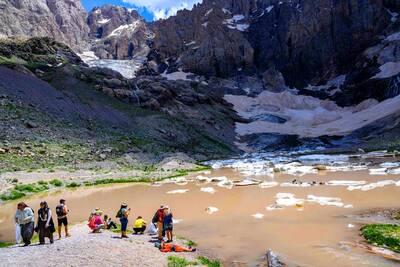
Kemal Ozdemir looked up at the bare peaks of Mount Cilo in Turkey’s Kurdish majority southeast. “There were glaciers 10 years ago,” he recalled under a cloudless sky. A mountain guide for 15 years, Ozdemir then turned toward the torrent carrying dozens of blocks of ice below a slope covered with grass and rocks — a sign of glacier loss being exacerbated by global warming. “You can see that there are quite a few pieces of glacier in the water right now ... the reason why the waterfalls flow lushly actually shows us how fast the ice is melting,” he said.
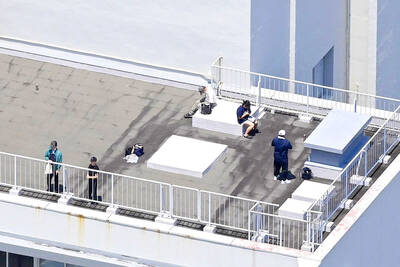
Residents across Japan’s Pacific coast yesterday rushed to higher ground as tsunami warnings following a massive earthquake off Russia’s far east resurfaced painful memories and lessons from the devastating 2011 earthquake and nuclear disaster. Television banners flashed “TSUNAMI! EVACUATE!” and similar warnings as most broadcasters cut regular programming to issue warnings and evacuation orders, as tsunami waves approached Japan’s shores. “Do not be glued to the screen. Evacuate now,” a news presenter at public broadcaster NHK shouted. The warnings resurfaced memories of the March 11, 2011, earthquake, when more than 15,000 people died after a magnitude 9 tremor triggered a massive tsunami that